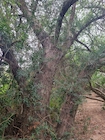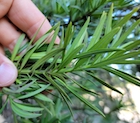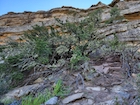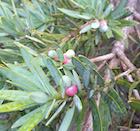Conservation Status

Podocarpus elongatus
(Aiton) L'Herit. ex Persoon 1807
Common names
Breede River yellowwood (Leistner 1966), Breëriviergeelhout [Afrikaans].
Taxonomic notes
Type: South Africa, Cape Province, F. Masson s.n. (lecto BM). This was the first species in the genus to be described, when Aiton (1789) assigned it to Taxus. Synonymy (POWO):
- Taxus elongata Aiton 1789;
- Nageia elongata (Aiton) F.Muell. 1876;
- Taxus capensis Lam. 1789;
- Podocarpus linearis Van Houtte ex Gordon & Glend. 1858, not validly publ.;
- Podocarpus pruinosus Eckl. & Zeyh. ex T.Durand & Schinz 1894;
- Podocarpus thunbergii var. angustifolius Sim 1907.
Two molecular studies have confirmed the long-standing perception that the three African species of Podocarpus share a clade within the genus. Knopf et al. (2012) considered all of the African species within the context of a study embracing the entire Podocarpaceae (including about half of all the Podocarpus species), placing the African taxa within a well-defined clade comprised of African and Malagasy species. A later, more detailed review (Migliore et al. 2020) sampled 88 specimens of P. latifolius from throughout the range of the species, using other African podocarps (Afrocarpus usambarensis and P. elongatus) as outgroups; they confirmed the close relationship of P. elongatus and P. latifolius, and moreover established divergence from a common ancestor as occurring about 6 million years ago, i.e. about the Miocene/Pliocene transition, at which time the fire-adapted plant communities with which P. elongatus is associated began, in some regions, to supplant the Afromontane forest where Podocarpus latifolius remains a dominant species (DuPont et al. 2011).
Description
Dioecious tree with rounded crown 3-6(-20) m tall, or spreading shrub; diameter of shrubs up to 12 m. Bark thin, gray-green to dark gray. Twigs pale yellow-green, round with grooves from decurrent leaf bases. Foliage buds 2-3 mm diameter, outer bud scales narrowly triangular-oblong, 4-6 mm long and about 1.5 mm wide. Leaves dimorphic, evergreen, generally retained 4-5 years, spirally arranged to subopposite, often crowded in upper parts of shoots, spreading to suberect, glaucous to gray-green above, narrowly oblong-elliptic, tapering in the upper 1/2 to 1/3, but more abruptly near the tip, acute to subobtuse; 30-60 × 4-5 mm (juvenile leaves up to 120 × 10 mm); margins flat to slightly recurved; midrib distinctly raised on lower surface, on upper surface slightly raised in proximal half. Pollen cones axillary in groups of 1-5, ±sessile, occasionally on pedicels up to 7 mm long, 14-19 × 4 mm, elongating up to 40 mm after shedding pollen; foliola 2-3 × 1.5-2 mm, ovate to transversely elliptic with a short tip, margin brown, scarious, denticulate. Seed cones solitary on 4-6(-13) mm long peduncles; receptacle fleshy, glaucous green ripening red, when ripe 9-15 × 10-16 mm, with 1-2 seeds. Seed within epimatium ellipsoid to ovoid, slightly apiculate, 7-10 mm long, dark glaucous green (Leistner 1966, Midgley et al. 1995). See García Esteban et al. (2004) for a detailed characterization of the wood anatomy.
Distribution and Ecology
South Africa: Eastern and Western Cape Provinces; Malawi; Zambia; Zimbabwe. Found at elevations of 130-2250 meters, primarily at moist sites, e.g. streams, in woodlands; also on rocky, sparsely vegetated sites (Farjon et al. 2013). Common woodland associates include Cunonia capensis and Olea capensis. In the Western Cape these habitats may adjoin the frequently-burned fynbos shrublands, and the burned Podocarpus may then resprout from the roots (an ability rare in conifers); this is the origin of the spreading shrub growth habit. In the northeast portion of its distribution, fire is less commonly a factor and plants more often grow into monopodial trees within a moist evergreen forest, where regeneration of this shade-tolerant species persists in the absence of major disturbance, producing a forest of long-lived trees with a negative-exponential size-class distribution. Regeneration in such forests is both from seed and from root sprouts (Midgley et al. 1995, Farjon 2010). Zone 10 (cold hardiness limit between -1°C and +4.4°C) (Bannister and Neuner 2001).
The IUCN finds P. elongatus to be of "Least Concern" for conservation due to an extensive range, the relative absence of exploitation, the low rates of habitat loss, and the adaptation for resprouting that renders it relatively indifferent to wildfire (Farjon et al. 2013).
Remarkable Specimens
No data as of 2023.02.07.
Ethnobotany
I have seen no uses specifically attributed to this species, but Podocarpus in general has been used within the Eastern and Western Cape Provinces to treat ailments including fevers, asthma, coughs, cholera, distemper, chest complaints, arthritis, rheumatism, painful joints and venereal diseases (Abdillahi et al. 2011 and citations therein).
During historical times, when there were larger trees, the timber was used for making wagons, chairs and general wood turning (Farjon et al. 2013). However, due to its small size and typically bushy habitat, the species has no current economic significance; neither is it generally cultivated, though some horticultural use is recorded (Farjon 2010).
Podocarpus elongatus has been the subject of a number of phytochemical investigations, with a variety of distinctive chemical constituents isolated from leaf and stem extracts. Some of these have potential pharmacological use, including antimicrobial, antiinflammatory and antioxidant activity; they may also have some chemotaxonomic value (Abdillahi et al. 2008, 2011; Faiella et al. 2012).
Observations
Large trees can be seen on the banks of the Breede River (from which it gets its common name) at the Bontebok National Park, Western Cape, South Africa (Farjon et al. 2013). Also, see the many observations on iNaturalist, most of which are in readily-accessible locales (including Bontebok).
Remarks
The epithet means "elongated", referring to the shape of the leaves.
Seeds and receptacles are eaten by birds and other animals (Leistner 1966).
Citations
Abdillahi, H. S., G. I. Stafford, J. F. Finnie, and J. Van Staden. 2008. Antimicrobial activity of South African Podocarpus species. Journal of Ethnopharmacology 119(1):191-194.
Abdillahi, H. S., J. F. Finnie, and J. Van Staden. 2011. Anti-inflammatory, antioxidant, anti-tyrosinase and phenolic contents of four Podocarpus species used in traditional medicine in South Africa. Journal of Ethnopharmacology 136(3):496-503.
Aiton. 1789. Hortus Kewensis 3:415. Available: Biodiversity Heritage Library, accessed 2023.02.07.
Dupont, L. M., H. P. Linder, F. Rommerskirchen, and E. Schefuß. 2011. Climate-driven rampant speciation of the Cape flora. Journal of Biogeography 38(6):1059–1068. https://doi.org/10.1111/j.1365-2699.2011.02476.x.
Faiella, Laura, Abeer Temraz, Nunziatina De Tommasi, and Alessandra Braca. 2012. Diterpenes, ionol-derived, and flavone glycosides from Podocarpus elongatus. Phytochemistry 76:172-177.
Farjon, A., W. Foden, and L. Potter. 2013. Podocarpus elongatus. The IUCN Red List of Threatened Species 2013: e.T42501A2983276. https://dx.doi.org/10.2305/IUCN.UK.2013-1.RLTS.T42501A2983276.en, accessed 2023.02.07.
Leistner, O.A. 1966. Podocarpaceae. Pp. 34-41 in L.E. Codd, B. De Winter and H.B. Rycrodt (eds.), Flora of Southern Africa, Volume I. Republic of South Africa Department on Agricultural Technical Services (as P. falcatus).
Midgley, J. J., W. J. Bond, and C. J. Geldenhuys. 1995. The ecology of southern African conifers. Pp. 64-80 in N. J. Enright and R. S. Hill (eds.), The Ecology of the Southern Conifers. Washington DC: Smithsonian Institution Press.
See also
Adie, Hylton, and Michael J. Lawes. 2011. Podocarps in Africa: temperate zone relicts or rainforest survivors? Pp. 81-100 in Turner, Benjamin L. and Cernusak, Lucas A. (eds.), Ecology of the Podocarpaceae in Tropical Forests. Smithsonian Contributions to Botany. https://doi.org/10.5479/si.0081024X.95.viii, accessed 2023.02.07.




